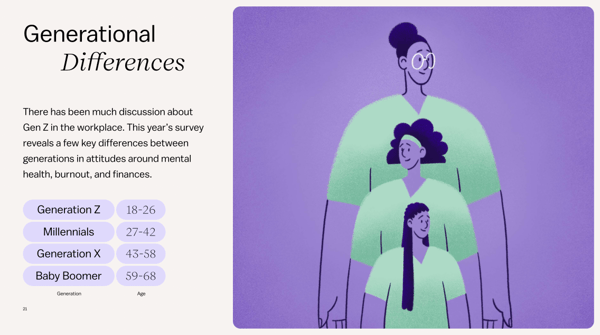Today, the healthcare industry finds itself at a critical juncture, with multiple stressors driving nurses and allied healthcare professionals (AHPs) out of the industry. For instance, a National Council of State Boards of Nursing study found that 100,000 registered nurses left the profession during the COVID-19 pandemic, and approximately 600,000 others plan to leave by 2027. Against this backdrop, Vivian produced our fourth annual Healthcare Workforce Report to assess clinicians' recent views and attitudes with an eye toward talent acquisition and retention.
We based our findings on survey responses by 863 clinicians collected from December 12, 2023, to January 11, 2024. Respondents included a mix of nurses (57%), AHPs (27%), certified nursing assistants (12%) and advanced practice providers (4%), including clinicians from all 50 states, Puerto Rico and the District of Columbia.
Our findings suggest that employers and recruiters must approach attracting and retaining talent holistically. That means addressing workplace climate issues and personal challenges clinicians face outside the clinic. When seeking a new job, pay remains a primary consideration for healthcare providers (HCPs), and pay transparency has become a best practice in hiring. However, more broadly, HCPs identified five significant aspects of their employment considerations that recruiters and employers would do well to keep in mind:
- Pay
- Work-Life Balance
- Staff-to-Patient Ratios
- Schedule Flexibility
- Location
These five considerations interplay with various challenges clinicians have identified in their home and work lives. Staffing agencies and talent acquisition teams should delve into the study details to consider the optimal approach to identifying, attracting and hiring talent in the current environment.
Unaddressed Workplace Problems Drive HCPs out of Healthcare
Our survey highlights why so many HCPs have left or plan to leave healthcare. Respondents cite burnout, poor staffing ratios and workplace violence as major areas of concern. Many clinicians report that their workplaces don’t adequately address these problems.
Burnout
Distressingly, 72% of our survey respondents report notable job burnout, rating their burnout level at a 3, 4 or 5 on a 5-point scale. Meanwhile, 71% feel the burnout levels in 2023 were as bad or worse than in 2022.
- Employer Reaction: Despite high burnout levels, only 17% of respondents say their employer has implemented a new process to help reduce burnout.
Facing burnout, large numbers of clinicians are considering significant career changes, such as leaving healthcare entirely (42%), taking more time off (40%), moving to a less stressful specialty (39%) or shifting to remote healthcare roles (32%). These shifts could create substantial staffing pressures, especially for in-person units in high-stress positions such as the emergency room or intensive care units.
Staffing Ratios
One cause of burnout is inadequate staffing on units. About 81% of clinicians say they would consider leaving an inadequately staffed job.
- Employer Reaction: While 14% of respondents report that staff ratios decreased in the past year, some 39% report that they increased (i.e., more patients per worker).
Workplace Violence
Burnout and understaffing may be contributing to a culture of violence such that 42% of clinicians feel unsafe at work. Almost half of surveyed HCPs (47%) reported experiencing violence against themselves or their coworkers in 2023. While patients or their families tend to be the main perpetrators of such violence, a stunning 24% of perpetrators were workforce peers, and 9% were doctors, suggesting that tensions at some units have reached a crisis level. On the plus side, 42% said violence decreased in 2023, versus 25% who reported an increase.
- Employer Reaction: The decrease in reported violence from last year may reflect that 52% of respondents say their employers have implemented safety protocols. Ninety percent of such respondents find the protocols at least somewhat effective, rating them 3, 4 or 5 on a 5-point scale.
Needs Outside the Workplace Influence Job Choices
HCPs often grapple with personal challenges that impact their job performance or choice of employer. Many clinicians face obligations to care for loved ones. Meanwhile, many healthcare workers, especially younger generations, cite the rising cost of living as an ongoing problem, with many relocating or taking on side hustles to compensate for rising costs.
Flexible Schedules and Caregiver Needs
Just over half of the survey respondents are caregivers responsible for children, elders or disabled family members. Yet half of these workers say their employers offer no support for this significant need, such as flexible hours, parental leave or care stipends.
A total of 57% of the caregivers in our survey say they can’t obtain adequate childcare or caregiving services. The pullback of support services offered during the pandemic, such as on-site childcare and flexible work schedules, continues to erode the foundation of the current hiring momentum industry-wide.
Cost of Living Issues and Side Hustles, Especially Among the Young
The intersection of “pay” and “location” as top-five job considerations reflects increasing concerns about rising living costs, especially housing. Rents and home prices typically have an inverse relationship, but at present, rents have recently climbed rapidly to record highs while home prices are also at a record, a problem compounded by higher mortgage rates.
To get by, “side hustles” have become common, with 35% of our survey respondents reporting doing extra work to offset inflation or develop alternate career options. More than half of these side hustles are within healthcare. This favored choice for part-time work presents employers with a significant opportunity to fill staffing gaps while satisfying this income demand by providing alternative, flexible work options to providers seeking extra shifts.

Younger generations experience these financial struggles most acutely, with Gen Z and Millennials more likely than Gen X and Baby Boomers to have moved last year to seek a lower cost of living (56% and 40% vs. 27% and 23%) and more likely to have side hustles (44% and 41% vs. 34% and 29%). Such financial woes may explain why 56% of Gen Z and 59% of Millennial respondents report experiencing clinical depression vs. 36% of Baby Boomers.
Staffing Agencies and Talent Acquisition Need 360° Approach
A 360-degree approach that balances pay with other quality-of-life needs will be increasingly important in the current hiring environment. Meanwhile, the ongoing mass retirement wave of Baby Boomers calls for an increased focus on the particular concerns of Gen Z and Millennial workers without diminishing the continued contributions of Gen X.
Read our 2024 Healthcare Workforce Report to get a complete picture of the current state of the workforce.
